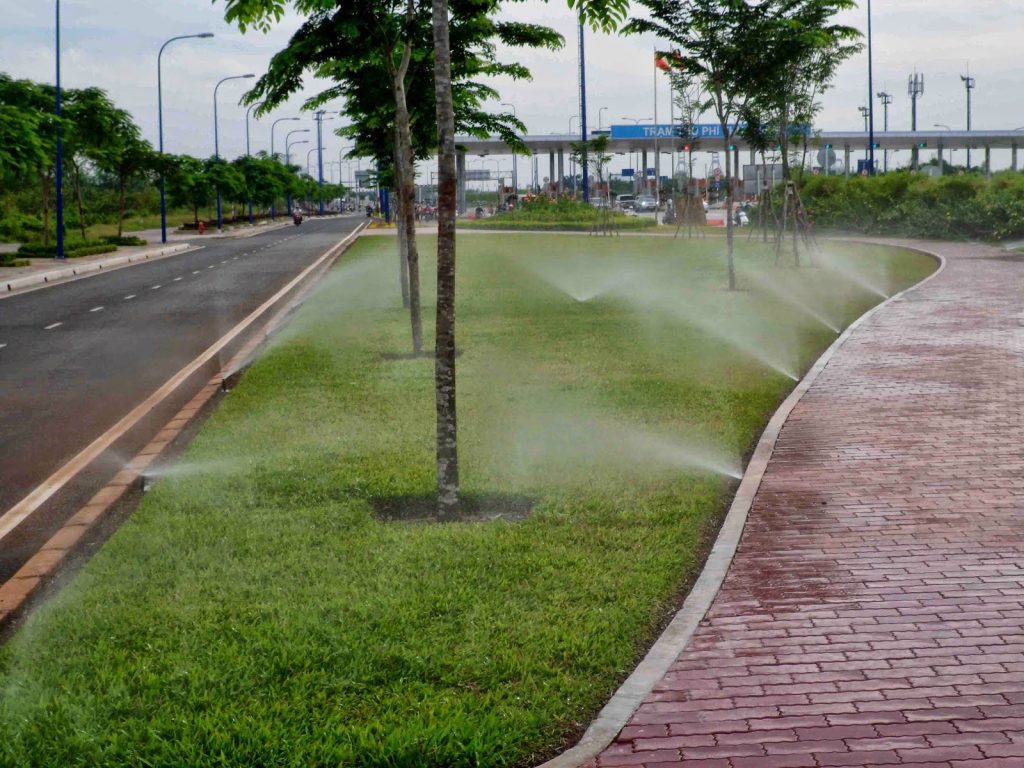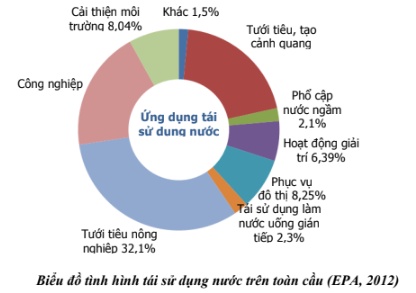
Do you know the importance of reuse of wastewater after treatment? Trends of reuse of domestic and foreign wastewater? All will be in our detailed article below.
1. Importance of industrial wastewater reuse after treatment
Although the current term wastewater reuse is not new, most readers still do not fully understand the meaning of this term. Wastewater reuse is understood as the reuse of wastewater after treatment with a clear purpose.
Wastewater reuse plays an important role in each country’s development strategy for sustainable economic shaping. The reuse of wastewater brings various benefits such as: reducing the amount of water exploited upstream, reducing the amount of water discharged into the environment, increasing economic efficiency, etc. Within urban areas, water is reused. Used can be taken to serve for road washing, urban greenery watering, fire fighting system supply and car washing. In the industrial sector, reused water can be supplied to cooling equipment, serving the stages that use water in the production and irrigation cycle.

Photo of water to water plants in public areas. Image source: Internet
Economically
- Reusing wastewater in some production stages can help save water use, thereby reducing the cost of using water as well as investment costs for building a water supply system for the process. production process.
- Reusing wastewater will reduce the volume of generated wastewater, thereby reducing the volume of wastewater treatment tanks, helping to save investment costs in treatment systems and related costs (cost of wastewater treatment). operation, discharge, etc.).
In terms of the environment
- Reduce pollution and wastewater discharge to surface water receiving sources.
- Increase water supply for production needs.
- Bringing benefits to agriculture as well as some urban applications (irrigation, fire fighting, landscaping, …).
- Improve the environment, improve surface water and groundwater.
2. Research situation abroad
In developed countries, due to the increasing awareness of the community about environmental and resource issues, and stricter standards on environment in general and wastewater in particular, businesses tend to apply appropriate technologies for advanced industrial wastewater treatment to meet increasingly high discharge standards. In addition, due to the increasing price of water for production, factories are looking for ways to reuse treated wastewater. Businesses investing in the reuse of wastewater after treatment not only achieve economic benefits, but also improve their image in the eyes of the community.
Nowadays, the reuse of industrial wastewater in developed countries has been deployed more and more widely, especially in some manufacturing industries that use a lot of water or can generate highly toxic wastewater such as industrial plants. industries: pulp and paper production, power plants, textiles and dyeing, food processing, etc. Today’s trend is to move to factories with increasingly radical levels of wastewater reuse, to the point that it can be called are “Zero Discharge” (zero discharge) plants.
Industrial wastewater reuse programs began in the United States in the 1940s when treated wastewater was disinfected and used in steel production lines. In Sweden, during the period from 1930-1970, the total water TSD flow increased by 5-6 times was recorded. During the last quarter of the 20th century, the benefits of promoting water TSD as a means of replenishing water resources were recognized by the United States and the European Union. Interest in wastewater reuse is growing in many other parts of the world to meet the need to provide reliable, high-quality water for agricultural, industrial and municipal use, but renewable technology Wastewater use was only adopted in Asia in the last quarter of the 20th century.
In European countries, the implementation of wastewater reuse depends on current regulations or guidelines, divided into 3 groups:
i) Countries that already have regulations and/or guidelines related to wastewater reuse such as France, Italy, Spain.
ii) Countries that plan to introduce regulations and/or guidelines related to water reuse such as Belgium, Greece, Portugal, Sweden, Netherlands, UK.
iii) Countries that do not have regulations and/or guidelines related to wastewater reuse such as Austria, Denmark, Finland, Germany, Ireland, Luxembourg.
Below is a chart of the global water reuse situation (EPA, 2012)

3. Research situation on industrial wastewater reuse in Vietnam
Research on wastewater reuse in Vietnam up to the 2000s was mainly related to cleaner production (CP) programs. Cleaner production has been popular since the 90s of the last century through the support projects of many donors such as Switzerland, Sweden, Canada, Denmark … and the efforts of the authorities at all levels.
Many enterprises in the textile, paper, food processing, metal processing industries in Hanoi, Ho Chi Minh City, Da Nang, Hai Phong, Nam Dinh, Ninh Binh and Phu Tho participated in production demonstrations. within the framework of the UNIDO-SECO project (VIE/96/023) and the project “Reducing industrial pollution – cleaner production” funded by UNIDO and SIDA (Sweden).
Over time, managers as well as manufacturers have acknowledged that cleaner production is an effective tool to reduce environmental pollution. Demonstration models at hundreds of production facilities and its benefits have been proven in practice, communicated in the mass media, but the extent and effectiveness of the clean production program. than was not as expected. Many businesses, especially small and medium enterprises, have not yet applied this tool, or have not applied it continuously. Experts at home and abroad said that there are factors that are considered barriers to CP in Vietnam. These barriers can be classified into four main categories:
i) State policy;
ii) The motivation of the production facility;
iii) Technical barriers;
iv) Management barriers.
Deeper cleaner production solutions such as reuse of wastewater in production involve technological lines, require significant capital investment and often require a period of time to stop production to implement, so there is little response. Therefore, the current situation of research and application of wastewater reuse in industrial production in general is still not much.
4. The Four Dublin Principles
To fully approach the perspective of sustainable development of water resources in the spirit of the United Nations Summit on Environment and Development held in Rio de Janeiro in 1992 and the four principles of water and sustainable development are The 1992 Dublin International Conference adopted:
Ecological principles
Clean water is a finite, vulnerable resource that is essential for life, development and the environment. Therefore, the integrated-use approach must take into account the components of water balance, development activities and impacts in each upstream area, multi-use, multi-sectoral linkages, human society and human society. nature. The proportion of unexploited natural flows reflects aquatic habitat conditions: 10% of the annual mean runoff will result in poor habitat, 30% good and >40% good.
Institutional Principles
Water resource development and management should be based on a participatory approach involving public and private stakeholders, communities and water users, planners, policies at all levels to reach mutual agreements of long-term and mutual responsibility, sharing, accepting sacrifices to improve water efficiency and protect water.
Social principles
Women have a central role in the protection, management and conservation of water, so it is important to include them in development projects, giving them the opportunity to have a voice to participate and benefit.
Economic principles
Water has economic value to all users and should be treated as a social and economic good, priced and distributed appropriately.
Conclude
Reusable water resources as well as natural water must be exploited, used efficiently, economically, multi-purposely, and harmonized benefits in the context of water resource decline due to climate change. This is very important in the context that water security is threatened, the situation of degradation, pollution and depletion of water resources is getting worse and worse.
Reference source: TECHNOLOGY TRENDS ANALYSIS REPORT – Compiled by: Center for Science and Technology Information HCMC- Work: Dr. Tran Minh Chi and the Institute of Tropical Technology and Environmental Protection.
In charge of the article: Do Thi Hue


 Tiếng Việt
Tiếng Việt 日本語
日本語